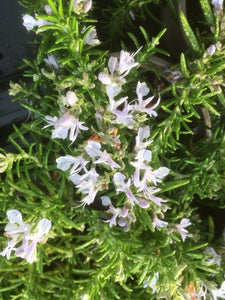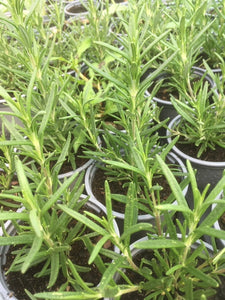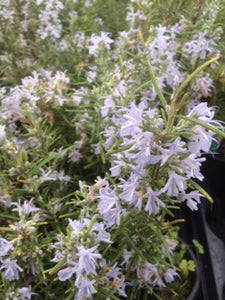Rosemary Plants: Our Complete Growing Guide
We specialise in growing Rosemary, a remarkable Mediterranean herb treasured since ancient times. This hardy plant brings both beauty and flavour to your garden, producing stunning white, pink, purple or blue flowers whilst growing up to 6 feet tall.
Our nursery-grown rosemary plants thrive for decades, often living 35 years or more with proper care. The aromatic leaves offer that distinctive earthy, citrusy flavour perfect for cooking, whilst natural compounds in the plant support brain health and help maintain blood sugar levels.
Let us share our expertise in
growing Rosemary successfully. From choosing the right variety to maximising your harvest, we'll guide you through container and garden growing methods. You'll discover practical solutions to common growing challenges, drawing from our years of experience cultivating these wonderful herbs.
Fresh Rosemary: A Garden Essential
Our passion for Rosemary stems from its remarkable versatility. This Mediterranean herb brings multiple rewards to your garden, from enhancing your culinary creations to supporting your well-being.
Fresh Rosemary in Your Kitchen
We love Rosemary's distinctive woodsy, piney flavour profile with subtle peppery notes. This versatile herb pairs beautifully with roasted meats, especially lamb, chicken, and oily fish. Our customers tell us how it adds wonderful depth to grains, mushrooms, potatoes, and various vegetable dishes.
Unlike delicate herbs, Rosemary holds its robust flavour through extended cooking. The sturdy stems serve brilliantly as flavourful skewers for grilling vegetables and meats. We particularly enjoy fresh sprigs steeped in water with orange slices for a refreshing summer drink.
Natural Health Benefits
Our nursery-grown Rosemary contains
over 50 different phytochemicals linked to remarkable health advantages. Each plant offers essential nutrients, including folate, vitamin A, vitamin C, vitamin B6, iron, calcium, and magnesium.
Scientific studies highlight Rosemary's impressive benefits:
- Memory improvement in university students after one month of supplementation
- Brain cell protection through carnosic acid
- 75% memory enhancement through simple inhalation, according to British researchers
Additional therapeutic properties include:
- Better sleep and reduced anxiety
- Enhanced immune function through natural antibacterial properties
- Improved digestive health
- Natural stress reduction
Beautiful Garden Features
We take pride in our Rosemary's striking ornamental value. These evergreen shrubs flourish for 10-15 years, creating a year-round structure with deep-green, needle-like foliage that contrasts beautifully against other plants.
Our rosemary varieties produce stunning nectar-rich blooms in blue, white, or pink, attracting essential pollinators to your garden - mason bees, honey bees, hoverflies and butterflies all adore these flowers.
The plants excel in drought-tolerant landscaping, offering versatility in design. Shape them into formal hedges or let them cascade naturally in containers. Their aromatic leaves naturally deter unwanted garden visitors like deer and rabbits.
Choose Your Perfect Rosemary Variety
We offer an extensive selection of rosemary varieties, each carefully chosen for its unique characteristics. Our expertise helps match you with the perfect plant for your garden goals and growing space.
Upright Varieties: Perfect for Cooking and Hedges
Our upright rosemary varieties shine in both kitchen gardens and formal landscapes.
Trailing rosemary varieties bring versatility to challenging spaces. 'Corsican Blue' stands as our chef's favourite, growing magnificently to 6-7 feet tall. Its wide leaves burst with concentrated aromatic oils, making it superb for cooking.
'Miss Jessopp's Upright' offers brilliant versatility for compact hedges. We love how it maintains shape with minimal care, taking up to 10 years to reach full size. Our 'Sudbury Blue' variety grows into a splendid 4-5 foot shrub, prized for its exceptional culinary qualities.
Trailing Types: Ideal for Containers and Ground Cover
'Prostratus' emerges as our classic trailing choice, reaching just 2 feet tall while spreading an impressive 4-8 feet wide. We recommend this variety for cascading over walls, hanging baskets or clothing slopes with fragrant greenery.
'Haifa' grows more compactly, about half the size of 'Prostratus'. Its closer leaf nodes create particularly dense ground cover. For colder gardens, we proudly offer 'Blue Lagoon', showing remarkable hardiness down to -9°C whilst spreading 2-3 feet yearly.
Distinctive Flavour Profiles
Each rosemary variety in our collection brings unique taste characteristics. 'Blue Lagoon' delights with complex notes of clove and nutmeg, whilst 'Miss Jessopp’s' offers refreshing hints of lemon mixed with pine.
Our varieties rich in verbenone (10-15%) deliver intense flavour without sacrificing yield. Though verbenone adds to Rosemary's distinctive taste, we find its presence isn't crucial for that classic rosemary flavour.
We recommend specific varieties for different cooking styles:
- 'Corsican Blue' - Perfect for bold, robust dishes
- 'Primley Blue' - Ideal for delicate recipes
- 'Rosemary Officinalis' - Excellent all-rounder for varied cooking
Here's just some of the varieties we offer at Culinary Herb Co:
A classic trailing rosemary, perfect for ground cover or adding cascading charm to containers.
The traditional upright Rosemary – beautifully aromatic and reliable in the kitchen garden.
Grown for its strong, straight stems – perfect for skewering food straight from the garden to the grill.
Compact and highly fragrant with narrow leaves and striking blue flowers – a smart choice for smaller spaces.
A hardy, semi-upright variety with deep blue flowers and a rich aroma – excellent for culinary and ornamental use.
A neat, upright form with a strong habit – well-suited to hedging or structured herb beds.
A delightful twist on tradition, this variety offers soft pink blooms and all the classic rosemary fragrance.
Unusual and eye-catching, with a warm gingery scent and a subtle difference in flavour.
A robust prostrate form from the Mediterranean, with excellent flavour and pale blue flowers.
Soft pink flowers and finely textured foliage make this variety both decorative and delicious.
Growing Perfect Rosemary Plants
We specialise in creating ideal conditions for Rosemary, this remarkable
Mediterranean native. Our years of experience show that mimicking its natural habitat ensures vigorous growth and abundant harvests throughout the seasons.
Sunlight Requirements
Our rosemary plants flourish with proper sunlight exposure. These sun-loving herbs need 6 to 8 hours of direct sunlight daily. We notice plants become weak without adequate light, developing pale leaves and producing fewer aromatic oils.
For indoor growing, we recommend positioning plants near south-facing windows for maximum sunlight. Our customers in hardiness zones 10 or 11 find dappled afternoon shade protects plants from intense summer heat.
Perfect Soil Preparation
We take particular care in creating the right soil environment for our Rosemary. These herbs thrive in well-draining, sandy or loamy soil with a pH between 6.0 and 7.0. Poor drainage leads to root rot - the most common cause of plant failure in our experience.
Our soil preparation method:
- Clear planting area of rocks, weeds, and debris
- Mix in organic matter or compost for better structure
- Add sand or grit, which is especially crucial for clay soils
For container growing, we use a specially formulated peat free herb potting mix. Our pots feature ample drainage holes, slightly elevated to ensure proper water flow.
Balanced Watering Techniques
We've mastered Rosemary's particular watering needs through years of cultivation. Though remarkably drought-tolerant once established, newly planted specimens need regular watering for their first fortnight.
Our ground-planted Rosemary receives deep but infrequent watering, with soil drying between sessions. Container plants need more frequent attention, typically every 2-5 days depending on weather conditions.
Our watering guide:
- Test soil moisture one inch deep
- Water thoroughly when the soil feels dry
- Ensure free drainage from containers
- Adjust frequency with seasons
Fascinatingly, our Rosemary absorbs significant moisture through its leaves, earning the charming nickname "upside-down plant". We maintain proper humidity whilst preventing waterlogged soil for optimal growth.
Rosemary Growing: Pots and Garden Beds
Our nursery specialises in growing Rosemary both in containers and garden beds. We take immense pride in sharing our expertise to help you choose the perfect growing method for your space.
Container Growing Success
Terracotta pots prove wonderful for rosemary cultivation. We love how their porous walls naturally regulate root temperature and allow proper water evaporation. For best results, we recommend containers measuring at least 12 inches across and 10-12 inches deep.
Our perfect potting mix combines 70% peat-free potting soil with 30% sand or grit for excellent drainage. Sometimes, we mix equal parts sand, peat-free compost, and perlite for variety. For larger pots over 30 litres, we add a 3-cm layer of expanded clay or gravel at the bottom.
Garden Bed Growing
We've found that raised beds offer superior conditions for Rosemary, particularly due to excellent drainage. Our preparation method includes mixing expanded clay, perlite, or gravel into the soil.
Our favourite placement tips:
- Sunny spots near rock walls
- Raised rocky beds
- Away from downspouts and flood-prone areas
Indoor Growing Methods
Moving Rosemary indoors needs special care. Position plants near
south-facing windows for 6-8 hours of sunlight daily. We maintain temperatures between 15-20 degrees during the day, dropping 10 degrees at night.
Our indoor care secrets:
- Group plants together for humidity
- Use gentle fan circulation
- Weekly container rotation
Through winter, we keep soil just moist between waterings. Our experience shows plants suffer near heat sources that cause drying.
Whether in pots or beds, Rosemary needs regular attention. We repot container plants yearly in fresh soil. Garden specimens thrive with good drainage and minimal watering once established.
Common Rosemary Problems: Our Solutions
Our years of growing experience have taught us how to tackle every rosemary challenge. We share these proven solutions to help your herbs flourish throughout the growing season.
Yellow Leaves: Quick Fixes
Yellow leaves tell us about the nutrient needs of rosemary plants.
Iron deficiency shows first in young leaves, whilst nitrogen deficiency affects older foliage. We check soil pH when iron issues arise, as levels above 7.0 block proper nutrient uptake.
Our nursery always starts with a soil test for precise diagnosis. We apply general-purpose water-soluble fertiliser (20-20-20) with micronutrients during active growth. Mind the nitrogen levels, though - too much reduces those precious essential oils.
Root Rot and Fungal Prevention
Root rot poses the greatest threat to our rosemary plants, especially in waterlogged soil. Look for brown or black roots with that telling decay smell. Our prevention methods:
- Let the top 2 inches of soil dry between waterings
- Use special free-draining potting mix
- Check pot drainage holes regularly
We spot powdery mildew as white powder on leaves, usually in warm, wet weather with cooler nights. Good airflow and careful watering keep this fungus at bay.
Pest Management
Our main concern comes from rosemary beetles - striking 6-7mm insects with metallic purple-green stripes. These beetles and their larvae feast on foliage from late summer through spring. Spider mites leave their calling cards with webs near leaf joints and yellow spots.
Our natural control methods:
- Hand-pick and destroy beetles when spotted
- Welcome helpful wildlife - birds and frogs love these pests
- Give plants a strong water spray
- Use neem oil or insecticidal soap for stubborn cases
Reviving Struggling Plants
When plants struggle, we first check the roots. Healthy roots look white and firm, whilst black, slimy ones signal rot. Finding some good roots? We trim away the bad bits and repot in fresh soil.
Keep temperatures near 15/16°C with good ventilation for recovery. Our indoor plants sit on pebble trays for humidity without wet feet. Most crucial - adjust watering straight away if you spot brown or wilting.
Wonderful Ways to Use Your Rosemary
We love sharing creative uses for our freshly harvested Rosemary. From soothing teas to natural beauty products, this versatile herb brings joy far beyond the kitchen.
Our favourite way to enjoy Rosemary starts with a warm cup of tea. Simply steep one fresh sprig in hot water for 5-10 minutes. We find a touch of honey and lemon brings out the perfect flavour.
This lovely brew offers remarkable benefits, eases anxiety, and sharpens memory.
Kitchen Creativity
We take pleasure in creating rosemary-infused oils and vinegars. Try steeping fresh sprigs in olive oil for a flavourful dipping oil or salad dressing base. Our herb-infused vinegar adds wonderful depth to marinades and dressings.
Keep your harvest fresh by freezing sprigs in water-filled containers. We love how this method preserves both colour and flavour. Our chef friends often use sturdy Rosemary stems as aromatic skewers for grilled vegetables and meats.
Natural Home Products
Our Rosemary finds its way into practical household items. We combine it with lemon peel and white vinegar for natural cleaning solutions. The herb's antimicrobial properties tackle common household bacteria brilliantly.
For hair care, we recommend rosemary water treatments. Studies show regular use boosts blood flow to hair follicles, supporting healthy growth. The anti-fungal properties help soothe itchy scalps and fight dandruff.
Try dried Rosemary for soap making - fresh herbs contain too much water and might spoil. We particularly love blending rosemary essential oil with tea tree oil for wonderfully fragrant results. These diverse uses keep our Rosemary giving long after harvest season ends.
Growing Rosemary: Our Passion, Your Success
We take immense pride in sharing our Rosemary growing expertise. Whether you choose containers or garden beds, this magnificent Mediterranean herb rewards you with culinary excellence, health benefits, and stunning ornamental value.
Our years of experience show that success comes from proper growing conditions. We've seen Rosemary thrive for decades with the right balance of sunlight, well-draining soil, and careful watering. Though challenges arise, our proven solutions keep plants growing vigorously through every season.
The joy of growing Rosemary extends far beyond the kitchen. We love watching our customers discover new uses, from brewing aromatic teas to crafting natural cleaning products. The plant's evergreen structure brings lasting beauty to gardens year-round. Our guide shares everything we've learned about nurturing these wonderful herbs, helping you grow healthy, productive plants that will flourish for years to come.
Frequently asked questions about Rosemary.
How do I prevent yellowing leaves in my rosemary plant?
Yellowing leaves often indicate nutrient deficiencies. Check soil pH and ensure it's not above 7.0, which can prevent nutrient absorption. Apply a general-purpose water-soluble fertiliser (20-20-20) with micronutrients during active growth periods, but avoid excessive nitrogen.
How long can a rosemary plant live?
With proper care, rosemary plants can thrive for 10-15 years in garden settings. Some hardy specimens have been known to live up to 35 years, reaching impressive heights of up to 6 feet and producing beautiful flowers in shades of white, pink, purple, or blue.
What are the best culinary herbs to grow alongside Rosemary?
Rosemary pairs beautifully with other culinary herbs such as thyme, oregano, sage, and basil. These herbs share similar growing conditions - well-drained soil, plenty of sunlight, and minimal watering. However, avoid planting Rosemary near mint, as mint prefers a more moisture-retentive environment.
Is Rosemary a perennial herb?
Yes, Rosemary is an evergreen perennial herb, meaning it will continue growing year after year. It provides year-round flavour and ornamental value. In colder regions, winter protection may be needed to help it survive frosty conditions.
Does Rosemary need winter protection in colder climates?
Rosemary is hardy but can struggle in really harsh winters, particularly in wet or frost-prone areas. If growing outdoors in colder regions, provide winter protection by mulching around the base with straw or bark chips. For potted plants, move them to a sheltered spot or into a greenhouse before the first frost, keeping them in a cool, well-lit area.
When does the Rosemary plant flower?
Rosemary typically flowers in early spring, though some varieties bloom sporadically throughout the year. These nectar-rich rosemary flowers range from pale blue to deep purple and attract beneficial pollinators like bees and butterflies. Regular trimming encourages fresh growth and prolonged flowering.
How can I create a thriving herb garden with Rosemary?
A well-planned herb garden with Rosemary should include other Mediterranean herbs such as thyme, lavender, and oregano. Plant in full sun with well-draining soil, spacing plants adequately to allow airflow. Raised beds or large containers with a light, sandy soil mix work well. Regular harvesting encourages bushy growth and enhances the garden's fragrance and beauty.
Can Rosemary be planted directly in gardens?
Yes, Rosemary flourishes when planted in gardens, particularly in well-drained, slightly alkaline soil. Choose a sunny, sheltered spot, and avoid areas prone to excessive moisture. Once established, Rosemary requires little maintenance, apart from occasional pruning to maintain shape and encourage new growth.
How do I plant Rosemary successfully?
To plant Rosemary, choose a sunny location with well-draining soil. Rosemary thrives in raised beds, containers, or garden borders with good airflow. Dig a hole slightly larger than the root ball, place the plant in, and backfill with a light, sandy soil mix. Water thoroughly after planting, but avoid overwatering.
Why is wet soil bad for Rosemary?
Rosemary hates wet soil as it leads to root rot, which is the most common cause of plant failure. Always ensure soil drains well by adding sand or grit, and avoid overwatering. If growing in a pot, use containers with drainage holes to prevent water from pooling at the roots.
What are the key benefits of Rosemary?
The benefits of Rosemary go beyond its delicious flavour. It is packed with antioxidants and anti-inflammatory compounds that support brain function, improve digestion, and boost circulation. Rosemary also has antimicrobial properties, making it a natural addition to homemade cleaners and herbal remedies.
What are the different types of Rosemary?
There are many types of Rosemary, each suited to different purposes:
• Miss Jessopp's – Tall, upright variety with intense aroma, perfect for culinary use.
• Prostratus – A trailing type, great for ground cover or cascading over walls.
• Primley Blue – Compact growth, ideal for hedging.
• Blue Lagoon – A hardy variety with stunning blue flowers.
Which rosemary variety is best for cooking?
If you're looking for culinary Rosemary, opt for varieties with high oil content, such as Corsican Blue, Miss Jessopp’s, or Rosemary Officinalis. These types offer the most robust flavour, making them perfect for meats, roasted vegetables, and infused oils.
When and how should I harvest Rosemary?
Harvesting Rosemary is best done in the afternoon when the essential oils are strongest. Snip sprigs with clean scissors just above a leaf node to encourage bushier growth. Fresh Rosemary can be used immediately or dried for long-term storage.
Why is Rosemary one of the best herbs for roasting potatoes?
Rosemary is a classic choice for roast potatoes because its robust, piney flavour complements crispy golden potatoes perfectly. Fresh or dried Rosemary can be tossed with olive oil, garlic, and salt before roasting for a fragrant and delicious dish.
What herbs pair well with Rosemary in a herb collection?
In herb collections, Rosemary pairs well with other Mediterranean herbs like thyme, oregano, sage, and lavender. These herbs share similar growing conditions and complement each other beautifully in cooking.
What are the different kinds of herbs to grow in a home garden?
There are several kinds of herbs you can grow depending on your needs:
• Culinary herbs – Basil, rosemary, thyme, oregano, and parsley
• Medicinal herbs – Chamomile, mint, and echinacea
• Aromatic herbs – Lavender and lemon balm
• Tea herbs – Peppermint, lemon verbena, and chamomile
Can Rosemary grow in poor soil?
Yes, Rosemary is very tolerant of poor soil, provided it has excellent drainage. It actually thrives in sandy, rocky, or lean soils, as overly rich soil can cause it to grow leggy with less intense flavour.
Does Rosemary grow well in its native soil?
Rosemary originates from the Mediterranean, meaning its native soil is dry, sandy, and well-draining. To mimic these conditions, mix sand or grit into your garden soil or plant rosemary in raised beds and pots.
How often should I water Rosemary with fresh water?
Rosemary requires fresh water, but only when the soil is dry. Water deeply but infrequently - around once a week for garden plants and every 2-5 days for potted Rosemary. Overwatering is the most common mistake, so always check soil moisture before watering
What makes Rosemary such an amazing herb?
Rosemary is one of our favourite herbs because it brings so much to the table - literally and figuratively. This amazing herb offers bold flavour, ornamental beauty, and impressive health benefits all in one. Whether used fresh, dried, or as an essential oil, its powerful antioxidant properties and ability to enhance memory, digestion, and mood make it a must-have in every garden and kitchen.
Can I grow Rosemary from cuttings?
Absolutely! Rosemary cuttings are a wonderful way to start your herb garden. We recommend choosing healthy nursery-grown cuttings for the best results. Plant them in well-drained soil in a sunny location, and they'll soon develop into hardy, fragrant plants. Cuttings and young plants require slightly more attention at first but quickly adapt and thrive with proper care.
How should I use sprigs of Rosemary in cooking?
Fresh sprigs of Rosemary are incredibly versatile. Strip the leaves for roasting meats, flavouring stews, or infusing oils and vinegar. The woody stems can also double as skewers - perfect for grilling vegetables or lamb kebabs. We also love steeping sprigs in water with citrus slices for a refreshing, aromatic drink.
What are the benefits of using organic Rosemary?
Organic Rosemary is grown without synthetic pesticides or fertilisers, making it a purer option for culinary and medicinal use. We love that organic Rosemary retains its full flavour and nutritional profile. It's especially ideal for making teas, infused oils, and natural remedies. Our nursery-grown, peat-free organic plants are cultivated with care to give you peace of mind and the freshest quality possible.
How can I tell if my rosemary plant has healthy woody stems?
As Rosemary matures, it develops sturdy, woody stems that support its upright growth. Healthy woody stems should be firm and greyish-brown in colour, with no signs of splitting or softness. These stems are excellent indicators of a well-established plant and are perfect for culinary use, especially when stripping leaves or using the stems for skewers.
What are the different forms of Rosemary I can grow?
Rosemary comes in various forms to suit your garden or container space. Upright forms like 'Corsican Blue' and 'Miss Jessopp's Upright' are ideal for hedging and culinary use, while trailing forms such as 'Prostratus' and 'Haifa’ cascade beautifully over walls and pots. Each form offers unique growing habits and ornamental value.
Why is Rosemary considered a fragrant herb?
Rosemary is prized as a fragrant herb thanks to its needle-like leaves packed with essential oils. Just brushing against the plant releases a burst of its earthy, piney aroma with hints of citrus and camphor. We particularly love how its fragrance fills patios and kitchens alike, making it one of the most satisfying herbs to grow and use.
Where does Rosemary naturally grow in the wild?
Rosemary is native to the Mediterranean region, where it thrives in sunny, rocky terrain. The plant is well-adapted to coastal climates with well-drained soil and minimal rainfall. We mimic these natural conditions in our nursery to grow strong, resilient plants that flourish across a range of garden environments.
What's the best way to harvest branches of Rosemary?
To harvest branches of Rosemary, use clean, sharp scissors to cut just above a leaf node. Choose mature stems that are not too woody, ideally in the aftrenoon when the plant's oils are most concentrated. Regular harvesting encourages fuller, bushier growth and keeps your plant producing flavourful foliage all season long.
































